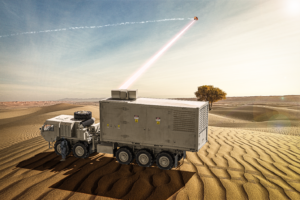Lockheed Martin [LMT] said Thursday it has delivered its 300-kilowatt class laser capability to the Pentagon four months ahead of schedule, with the system set to support the Army’s effort to have tactical vehicle-mounted high energy laser prototypes by fiscal year 2024.
The 300-kilowatt laser, the company’s most powerful to date, was delivered on Aug. 8 and developed for the Office Under Secretary of Defense for Research and Engineering’s (OUSD R&E) High Energy Laser Scaling Initiative (HELSI) program, with company officials noting future opportunities to go after more than 500 kilowatts in power.

“The HELSI OUSD roadmap absolutely extends beyond 300 kilowatts. It goes to 500 kilowatts. And it’s not just [about] power, but also space, weight and power that goes along with these designs. It’s 500 within a smaller kilogram per kilowatt package and then extending one step further to a megawatt-class high energy laser,” Tyler Griffin, Lockheed Martin’s director of advanced product solutions strategy and business development, told reporters on Thursday. “We see a great opportunity in the next three to four years to scale to that 500-kilowatt [power] and then extend beyond that in the 2028 timeframe to the megawatt-class, if not sooner.”
Race McDermott, Lockheed Martin’s business development lead for airborne directed energy and high-energy laser scaling efforts, noted that work to continue on future phases of HELSI to get after power levels beyond 300-kilowatts would require a new contract action.
Lockheed Martin is one of three vendors working on OUSD R&E’s HELSI initiative since 2019, with the company noting it was the first to deliver its laser for the program.
“[HELSI] is yet another step in proving that these systems are ready and are able to be deployed as really force multipliers and as part of the directed energy and kinetic energy mix that our warfighters can use to defend against threats like rockets, artilleries, mortars, cruise missiles, UAVs, and small ships,” Rick Cordaro, Lockheed Martin’s vice president of advanced product solutions, told reporters. “Over the last three years, we have designed, built and tested this high energy laser and it is now in the hands of the government.”
The Army has sponsored Lockheed Martin’s 300-kilowatt laser, which will be used for the Indirect Fire Protection Capability-High Energy Laser (IFPC-HEL) program, while the other HELSI vendors include Nutronics Inc. sponsored by the Navy and General Atomics by the Air Force.
“[OUSD R&E] is going to make those [laser] sources available to the services to support their demonstration efforts, which are independent of HELSI. So IFPC[-HEL] is one of those demonstration efforts. That’s being led by the Army. And that program did not develop a laser source because it’s reliant upon this OUSD program to provide this laser source to it. Our laser source was selected by the Army out of the potential ones that are coming out of the HELSI program and they’re leveraging that laser source to complete their demonstrations of ground-based laser weapon system capability with the IFPC-HEL demonstrator program,” McDermott said.
The Army’s plan for IFPC-HEL is to deliver four prototype 300-kilowatt lasers integrated on tactical vehicles to a platoon by FY ‘24.
“As you know, there were multiple vendors selected for HELSI and Lockheed Martin really focused on expanding our production capacity internally to make sure that we can deliver this system in a timely fashion. So we’re really proud to be the first out of the gate…and deliver and have OUSD [R&E] independently check out our laser and confirm that it met the requirements for their program first,” McDermott said. “That’s a big deal because it’s supporting this Army RCCTO effort and time was very important to them to meet the schedule objectives for that program.”
McDermott noted the IFPC-HEL program is heading into lab testing this fall and then field testing through FY ‘23, which follows Lockheed Martin’s testing of its HELSI laser in a lab setting at the company’s facility in Bothell, Washington and independent testing conducted by OUSD R&E.
The HELSI program aimed to get after scaling up solid state electric laser technology up to the 300-kilowatt class level “while retaining high beam quality” and reducing size and weight requirements, according to McDermott.
“I think we have scaled it down to the point where it is deployable on existing ground, sea and even potentially some air platforms. So I think there’s been some great progress that the HELSI program has made there,” McDermott said.